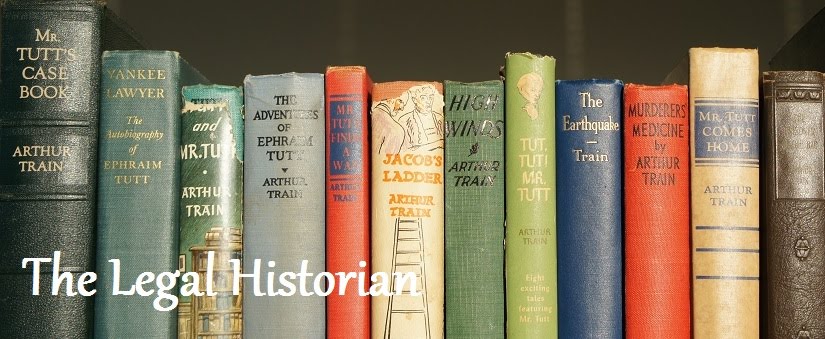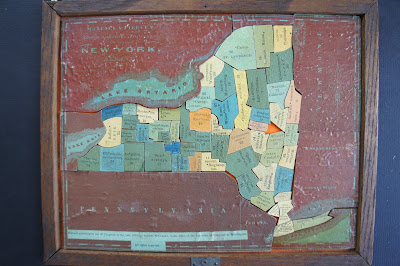Thanks to the Civil War letters, I was familiar with Edward McCleary, so it seemed likely that Samuel McCleary was a relation (and a second look at the letters showed that Samuel was Edward's father). As it was bound by string, it seemed something must have been inside of it. But what? It is only about 1/4 or 1/2 an inch wide and made of wood. I looked to the back of it to see if it gave any clues, and this is what it looked like:
 |
| A Table of Explanations, Showing Distances Between Major Cities in New York State |
Moving it, a few pieces of wood fell from it, and when I untied the string, I realized I had a puzzle on my hands. A puzzle of New York State and all of its counties. Since I have lived in New York for my entire life, I thought I might as well try to put the thing together and see if I had all of the pieces. But, New York is a tricky state, with counties that are ridiculously small (and several of them were barely familiar to me). I went to work, but the puzzle was harder than I thought. Maybe 45 minutes or so into trying to put it together, I finally caved in and googled a map of the counties of NYS, and ultimately I got the whole thing together. Well, almost.
I was missing Schenectady. I wondered if the missing piece was the type of thing I could find on ebay, so I turned to the computer to do a little investigating and I found out that there does not appear to be another puzzle exactly like the one I have. You see, Samuel McCleary was actually one of the first jigsaw puzzle makers in the United States. What I had before me appeared to be his prototype. Samuel McCleary partnered with John Pierce to create McCleary & Pierce, and they patented in 1849 a special diecast method of cutting jigsaw puzzle pieces. The puzzle was created in 1850, winning the acclaim of esteemed educator Emma Willard, as well as the Governor of New York State.
 |
| The Puzzle Was Recommended by Many Influential Persons |
 |
| Schenectady, the Missing Piece |
The next day, waiting until the civilized hour of 7am, I called my mother, frantic, asking whether she could check to see if Schenectady had somehow been left where she had found the rest of the puzzle, or if she could otherwise search everywhere for the missing piece. Unfortunately, it was too late. She said that she had vacuumed the closet where she had found the puzzle, and she didn't know where else the piece would be (note: cleanliness can be overrated, especially when looking for very small things). I was crushed. As a lover of history, holding in my hands something so old and significant as perhaps the first jigsaw puzzle made in the United States, I felt that the whole puzzle needed to be preserved. Including Schenectady.
I told my mother all about the history of the puzzle, and she was very excited and promised to be on the lookout for an orange triangular piece of wood, but the search seemed futile.
About one and one-half months later, on my mother's birthday no less, she called my cell phone and left a message (I was at work). I figured she had called to thank me for the card I had sent, but when I listened to her voicemail, I could hardly believe what she had said. She had found Schenectady! When she first found the puzzle, it had been inside of a cardboard box. By the time she gave it to me, she had no idea what had come of that box. But, on that fateful birthday morning, she was putting a few things in a box to give to my sister when she caught a glimmer of a little orange piece of wood on the bottom! Schenectady! The puzzle would be complete! And this amazing piece of history will soon be intact (considering what we have been through searching for it, with the vacuuming moratoriums and countless phone calls pining away over a 1/4 inch piece of wood, it's not like she could just mail it to me--this is the type of thing that can only be delivered in person).
I am planning to visit my parents sometime this month, and when I do, my mother has promised to hand over one of the smallest counties in New York State (thanks to the puzzle, I know such NYS county trivia) so the whole puzzle can be together again. So, for now, I leave you with a final picture of the incomplete puzzle. The gaping whole is, of course, Schenectady.
If you'd like to see more pictures, which can be made much larger, please visit my website by clicking here.
(I found that there are actually t-shirts for sale with a picture of Samuel McCleary's & John Pierce's Dissecting Map of the State of New York. My mother received a belated birthday present of this t-shirt--after all, we were basically obsessed with finding the missing piece for over a month and sort of bonded with the puzzle in the process. The t-shirt is available here).






